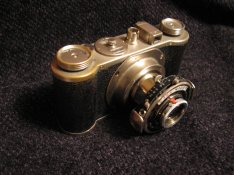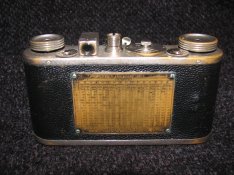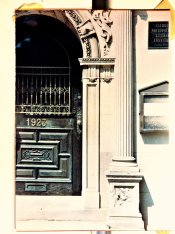David Lyga
Member
“Pre-War Proficiency”: That titular phrase is not oxymoronic. Why? Because it is true and quantitatively verifiable.
We all know that pre-war Leicas and Contaxes are admirable, capable machines, but we also know that high cost at least partially answers the question ‘How was that achieved back in the 1930s?’ However, my presentation of this entirely pedestrian Bavarian 35mm camera, the Wirgin Steinheil Munchen, with collapsible Cassar f2.9 / 5 cm triplet, (I hope I got it right!) achieves noteworthy credibility, synergized with a relatively low initial cost, because it does not have a rangefinder, only a viewfinder. It is a simple camera with a collapsible lens that performs well. It even has a working self-timer.
A year ago I bought this item for about $5 at a camera show (see front and rear of this camera, below). It is simple in construction but very solid. (Indeed, foam does not exist in this camera; neither do light leaks. They could achieve that back then. Why not now?)
First, I removed the four screws holding the lens/shutter assembly to the body. As there are no linkages, removal was simple. I then unscrewed and removed all the lens elements, flushed the shutter/aperture mechanics with lighter fluid, let it dry completely overnight in my oven, (which is lit by a pilot light), making certain to periodically fire the shutter and move the aperture blades during the drying process, cleaned the glass thoroughly, and reassembled the components. But before reattaching the lens/shutter to the body, I removed the top of the camera and cleaned it manually because I did not want to get liquid into the viewfinder (which I could not get into to clean thoroughly). I then bathed the naked body, sans lens, in warm, soapy water, rinsed thoroughly, let dry completely, then reassembled the simple, whole unit and had, finally, a very clean camera that actually worked (without fear of internal grime mitigating that achievement). I then tested it and re-determined the precise focus position for infinity on that lens. Now, I was ready to test further.
The shutter has engraved (but odd) stated speeds of 175th second to 1 second, plus B and T. Not all the shutter speeds work properly, but most do. On the extant shutter scale I superimposed an EV scale to best approximate the actual speeds currently available. They are, as actually timed:
EV 8 (250th), EV 7 (125th), EV 6 (60th), EV 5 (30th), next is skipped, then EV 4 (15th), EV 1 (1/2), EV 0 (1 sec), B, T.
Of course, there is no provision for flash sync. But, somewhat oddly, the tripod socket is not European, it is American, and the focus scale is in feet, not meters.
The almost perfectly circular aperture has 13 blades. If bokeh is relegated to be unimportant by some, why this extra cost and labor? It must have mattered. Even back then they were smart.
F2.9 was fairly fast during the 1930s. How did it perform? I wanted to provide color for this test because this lens is not coated. In addition, I wanted to provide one photo at the full f2.9 aperture (doorway 1923) just to see how worthy that ‘large’ aperture would be. The lens formula, formulated with naked, manual, mental acuity (before Bill Gates and his computers were consulted, or even conceived), is a mathematical achievement which few of us really appreciate. Today, computers do the math and, admittedly, produce far more sophisticated glass with better possibilities. Yet, I consider this lens to be quite admirable (prints and negs are sharper than you see here) because it must have been sold at a relatively low price (I do not know for how many Deutschmarks back then, but it was well after the German hyperinflation period of the early twenties) and this has to give one cause to revel at the achievement that was not only probable and possible, but, indeed, profoundly manifest and supposedly profitable with such a rather pedestrian camera that was not ever sufficiently costly to harbor a rangefinder or other frills. – David Lyga
We all know that pre-war Leicas and Contaxes are admirable, capable machines, but we also know that high cost at least partially answers the question ‘How was that achieved back in the 1930s?’ However, my presentation of this entirely pedestrian Bavarian 35mm camera, the Wirgin Steinheil Munchen, with collapsible Cassar f2.9 / 5 cm triplet, (I hope I got it right!) achieves noteworthy credibility, synergized with a relatively low initial cost, because it does not have a rangefinder, only a viewfinder. It is a simple camera with a collapsible lens that performs well. It even has a working self-timer.
A year ago I bought this item for about $5 at a camera show (see front and rear of this camera, below). It is simple in construction but very solid. (Indeed, foam does not exist in this camera; neither do light leaks. They could achieve that back then. Why not now?)
First, I removed the four screws holding the lens/shutter assembly to the body. As there are no linkages, removal was simple. I then unscrewed and removed all the lens elements, flushed the shutter/aperture mechanics with lighter fluid, let it dry completely overnight in my oven, (which is lit by a pilot light), making certain to periodically fire the shutter and move the aperture blades during the drying process, cleaned the glass thoroughly, and reassembled the components. But before reattaching the lens/shutter to the body, I removed the top of the camera and cleaned it manually because I did not want to get liquid into the viewfinder (which I could not get into to clean thoroughly). I then bathed the naked body, sans lens, in warm, soapy water, rinsed thoroughly, let dry completely, then reassembled the simple, whole unit and had, finally, a very clean camera that actually worked (without fear of internal grime mitigating that achievement). I then tested it and re-determined the precise focus position for infinity on that lens. Now, I was ready to test further.
The shutter has engraved (but odd) stated speeds of 175th second to 1 second, plus B and T. Not all the shutter speeds work properly, but most do. On the extant shutter scale I superimposed an EV scale to best approximate the actual speeds currently available. They are, as actually timed:
EV 8 (250th), EV 7 (125th), EV 6 (60th), EV 5 (30th), next is skipped, then EV 4 (15th), EV 1 (1/2), EV 0 (1 sec), B, T.
Of course, there is no provision for flash sync. But, somewhat oddly, the tripod socket is not European, it is American, and the focus scale is in feet, not meters.
The almost perfectly circular aperture has 13 blades. If bokeh is relegated to be unimportant by some, why this extra cost and labor? It must have mattered. Even back then they were smart.
F2.9 was fairly fast during the 1930s. How did it perform? I wanted to provide color for this test because this lens is not coated. In addition, I wanted to provide one photo at the full f2.9 aperture (doorway 1923) just to see how worthy that ‘large’ aperture would be. The lens formula, formulated with naked, manual, mental acuity (before Bill Gates and his computers were consulted, or even conceived), is a mathematical achievement which few of us really appreciate. Today, computers do the math and, admittedly, produce far more sophisticated glass with better possibilities. Yet, I consider this lens to be quite admirable (prints and negs are sharper than you see here) because it must have been sold at a relatively low price (I do not know for how many Deutschmarks back then, but it was well after the German hyperinflation period of the early twenties) and this has to give one cause to revel at the achievement that was not only probable and possible, but, indeed, profoundly manifest and supposedly profitable with such a rather pedestrian camera that was not ever sufficiently costly to harbor a rangefinder or other frills. – David Lyga
Attachments
Last edited by a moderator:

















